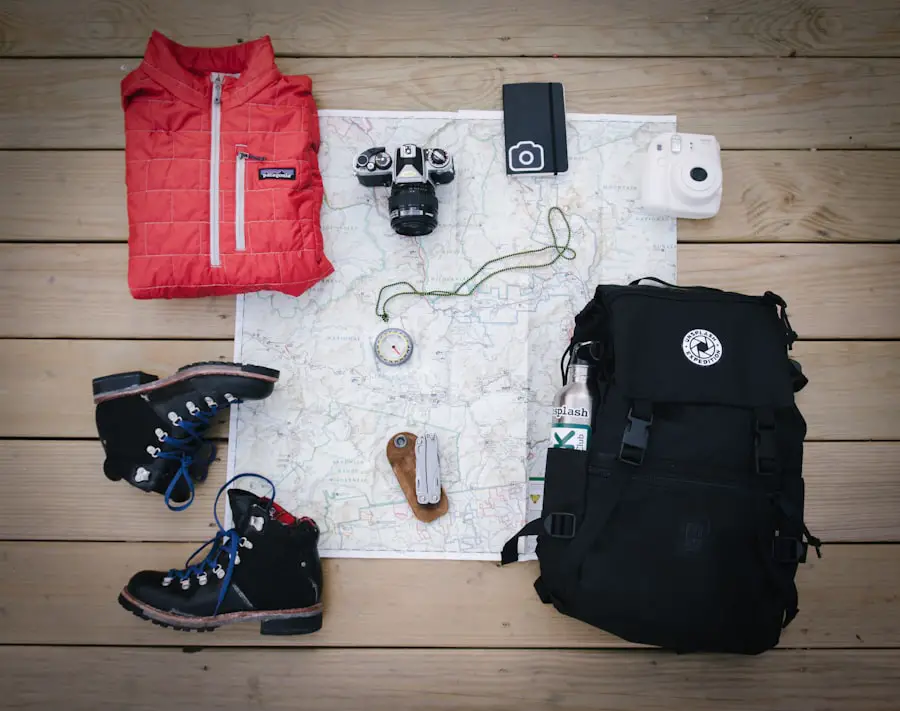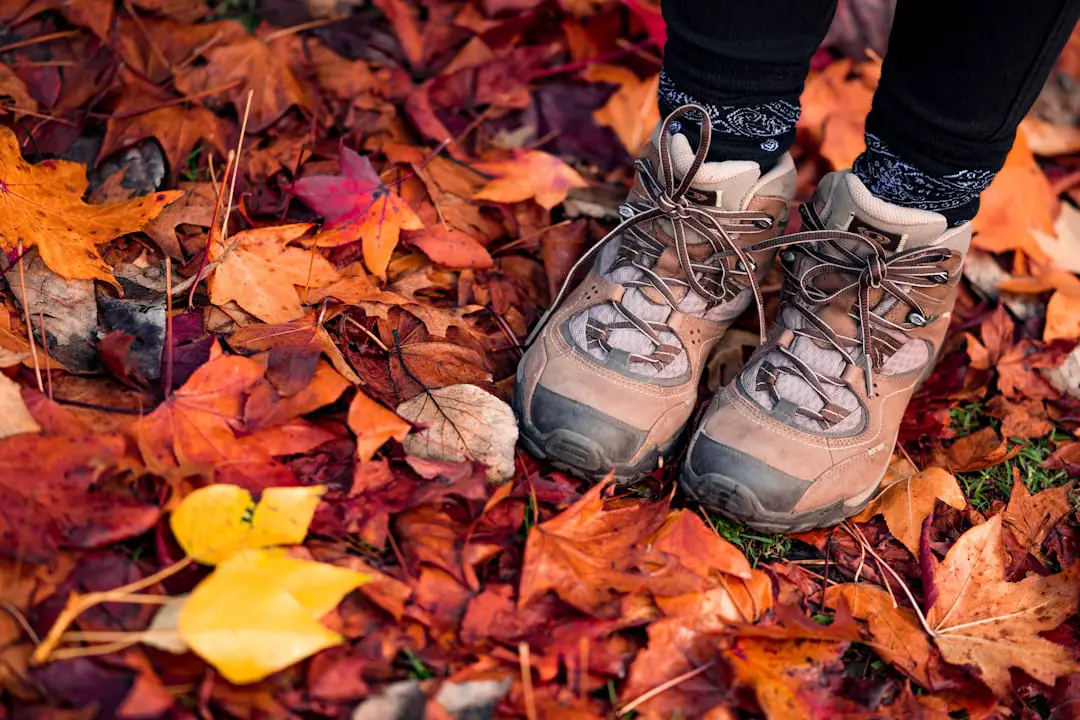Selecting the appropriate hiking boots is a critical first step in ensuring a comfortable and enjoyable outdoor experience. The right pair of boots should cater to your specific foot shape, size, and the type of terrain you plan to traverse. When considering fit, it is essential to try on boots at the end of the day when your feet are slightly swollen, as this mimics the conditions they will experience during a hike.
Look for a snug fit around the heel to prevent slippage, while ensuring there is enough room in the toe box to wiggle your toes without feeling cramped. A good rule of thumb is to have about a thumb’s width of space between your longest toe and the front of the boot. Additionally, consider the type of hiking you will be doing.
For instance, if you plan on tackling rugged mountain trails, opt for boots with stiffer soles and more aggressive tread patterns for better traction and support. Conversely, if your hikes are more casual or on well-maintained paths, lighter boots or even trail runners may suffice. Pay attention to the materials used in the construction of the boots as well; leather offers durability and water resistance, while synthetic materials can provide breathability and lighter weight.
Ultimately, the right hiking boots should feel like an extension of your feet, providing support and comfort without any pressure points.
Key Takeaways
- Choose hiking boots that fit your feet properly to avoid discomfort and injury.
- Breaking in hiking boots is important to prevent blisters and foot pain during long treks.
- Prepare your hiking boots for breaking in by cleaning and waterproofing them.
- Gradually increase wear time to allow your feet to adjust to the boots.
- Use different terrains to break in your hiking boots and test their performance.
Understanding the Importance of Breaking in Hiking Boots
Breaking in hiking boots is a crucial process that cannot be overlooked. New boots often come with stiff materials that require time to soften and mold to the unique contours of your feet. This process is essential for preventing blisters, calluses, and other discomforts that can arise from wearing unbroken-in footwear on long hikes.
The breaking-in period allows the materials to adapt to your foot shape, ensuring that they provide adequate support and cushioning where needed. Moreover, breaking in your hiking boots helps to identify any potential issues before embarking on a long trek. During this period, you can assess how the boots perform under various conditions and make adjustments if necessary.
For example, if you notice that a particular area of the boot is rubbing against your foot, you can address it by using moleskin or adjusting your lacing technique before it becomes a significant problem on the trail. Understanding this process not only enhances comfort but also contributes to overall foot health during outdoor activities.
Tips for Preparing Your Hiking Boots for Breaking In

Before you even step outside with your new hiking boots, there are several preparatory steps you can take to facilitate the breaking-in process. First, consider applying a leather conditioner or waterproofing treatment if your boots are made from leather or have leather components. This not only helps to soften the material but also protects against moisture and dirt, which can lead to premature wear.
Additionally, ensure that you have the right socks for your hikes; moisture-wicking and cushioned socks can significantly enhance comfort and reduce friction. Another effective strategy is to wear your new boots around the house or during daily activities. This allows you to gradually acclimate your feet to the new footwear without subjecting them to the rigors of a hike right away.
Start with short periods of wear—perhaps an hour or two—and gradually increase this time as your feet become accustomed to the boots. Pay attention to how they feel during these initial wears; if you experience any discomfort, it’s better to address it early on rather than waiting until you’re miles into a hike.
Gradually Increasing Wear Time for Your Hiking Boots
| Week | Wear Time (hours) | Distance (miles) |
|---|---|---|
| 1 | 2 | 5 |
| 2 | 3 | 7 |
| 3 | 4 | 10 |
| 4 | 5 | 12 |
Once you’ve taken initial steps to prepare your hiking boots for breaking in, it’s time to gradually increase their wear time. This incremental approach is vital for allowing your feet to adjust without overwhelming them. Start with short walks on flat surfaces, which will help you gauge how the boots feel during movement without putting too much strain on your feet or ankles.
As you become more comfortable, incorporate longer walks and varied terrains into your routine. During this phase, it’s important to listen to your body. If you start feeling discomfort or pain in specific areas, take note of these sensations and adjust accordingly.
You might need to loosen laces in certain spots or try different sock combinations. The goal is to build up tolerance while ensuring that any potential issues are addressed early on. By gradually increasing wear time, you not only help your feet adapt but also allow the boots themselves to flex and conform to your unique foot shape.
Using Different Terrains to Break in Your Hiking Boots
To effectively break in your hiking boots, it’s beneficial to expose them to various terrains. Different surfaces can challenge the boot’s flexibility and support in unique ways, helping them adapt more thoroughly to your foot’s movements. Start with easy trails that feature a mix of flat ground and gentle inclines; this will allow you to test how well the boots grip and support you without overwhelming your feet.
As you gain confidence in your boots, venture onto more challenging terrains such as rocky paths or uneven ground. These conditions will help assess how well the boots protect your feet from sharp objects while providing stability on unpredictable surfaces. Additionally, walking through mud or shallow water can help test waterproofing features and drainage capabilities.
By diversifying the environments in which you break in your boots, you ensure that they are well-prepared for any hiking adventure you may undertake.
Dealing with Discomfort During the Breaking in Process

Experiencing discomfort during the breaking-in process is not uncommon; however, it’s essential to differentiate between normal adjustment pains and signs that something may be wrong with the fit of your boots. If you encounter minor discomfort such as slight rubbing or pressure points, it may simply be a matter of allowing more time for the materials to soften and mold around your feet. In these cases, using blister prevention products like moleskin or blister pads can provide immediate relief while allowing you to continue breaking in your boots.
On the other hand, if you experience sharp pain or persistent discomfort in specific areas, it may indicate that the boots are not suitable for your foot shape or size. In such instances, it’s advisable to reassess the fit and consider trying a different model or brand altogether. Remember that hiking should be an enjoyable experience; if your boots are causing significant pain during the breaking-in phase, it’s worth investing time in finding a pair that truly fits well.
Taking Care of Your Feet While Breaking in Hiking Boots
While breaking in new hiking boots, taking care of your feet is paramount for ensuring a smooth transition into comfortable trekking. Start by maintaining proper foot hygiene; wash and dry your feet thoroughly before putting on socks and boots. This helps prevent moisture buildup that can lead to blisters and fungal infections.
Additionally, consider using foot powder or anti-chafing creams to reduce friction between your skin and socks or boot linings. Investing in high-quality socks is another crucial aspect of foot care during this period. Look for socks made from moisture-wicking materials that provide cushioning without adding bulk.
Avoid cotton socks as they retain moisture and can lead to blisters when combined with new boots. Furthermore, pay attention to nail care; keeping toenails trimmed can prevent them from hitting against the front of the boot during descents, which can be painful over time.
Recognizing When Your Hiking Boots Are Fully Broken In
Determining when your hiking boots are fully broken in requires careful observation of how they feel during wear. A well-broken-in boot should feel comfortable with no areas of excessive rubbing or pressure points. You should be able to walk for extended periods without experiencing pain or discomfort in any part of your foot.
Additionally, check for flexibility; a properly broken-in boot will bend easily at the ball of the foot while still providing adequate support. Another indicator of a successful break-in period is how well the boot conforms to your foot shape. You should notice that the materials have softened and molded around your feet, providing a snug yet comfortable fit without any pinching or tightness.
If you’ve tested them on various terrains without issues and they feel like a natural extension of your feet, it’s likely that they are ready for more challenging hikes.
Maintaining Your Hiking Boots for Longevity and Comfort
Proper maintenance of hiking boots is essential for ensuring their longevity and continued comfort throughout their lifespan. After each hike, take time to clean off dirt and debris from both the exterior and soles of the boots using a soft brush or cloth. This prevents buildup that can damage materials over time and helps maintain traction on future hikes.
If your boots are waterproof, ensure that you reapply waterproofing treatments periodically based on usage frequency. Additionally, store your hiking boots in a cool, dry place away from direct sunlight when not in use. Avoid leaving them in damp areas or hot vehicles as these conditions can degrade materials over time.
Consider using boot trees or stuffing them with newspaper when storing them; this helps maintain their shape and prevents creasing in the leather or fabric.
Common Mistakes to Avoid When Breaking in Hiking Boots
When breaking in hiking boots, several common mistakes can hinder comfort and lead to foot problems down the line. One prevalent error is rushing through the break-in process by wearing new boots on long hikes right away; this can result in blisters and discomfort that could have been avoided with gradual acclimatization. Instead, take time to break them in through shorter walks before tackling more strenuous trails.
Another mistake is neglecting sock choice; wearing cotton socks instead of moisture-wicking options can lead to blisters due to increased friction when combined with new footwear. Additionally, failing to pay attention to fit can be detrimental; if you notice persistent discomfort during initial wears, don’t ignore it—addressing fit issues early on can save you from significant pain later.
Enjoying Comfortable and Pain-Free Trekking with Properly Broken in Hiking Boots
Once you’ve successfully broken in your hiking boots through careful selection, gradual wear, and attentive maintenance, you’ll be well-equipped for comfortable trekking experiences. Properly broken-in boots will allow you to focus on enjoying nature rather than worrying about foot pain or blisters. With each step feeling secure and supported, you’ll find yourself more willing to explore new trails and push further into the wilderness.
The joy of hiking lies not only in reaching scenic vistas but also in experiencing nature’s beauty along the way. With well-fitted and broken-in hiking boots at your side, every trek becomes an opportunity for adventure rather than a test of endurance against discomfort. Embrace each journey with confidence knowing that you’ve taken all necessary steps for a pain-free experience on the trails ahead.
If you’re looking for tips on how to break in hiking boots, you may also be interested in learning about the benefits of a
